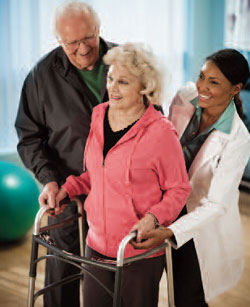Spine Surgery - Prepare
What to Pack Checklist
You may pack a duffel bag or a small carry-on size luggage.
Include:
- Loose fitting shorts or pants with an elastic waist. Button down tops for easy on/off.
- Shoes, either slip on or closed back, with a rubber sole or tread on the bottom to prevent falls. Yellow slipper socks will be provided.
- Incentive Spirometer (IS) for breathing exercises
- Breathing machine for sleep apnea if one is used at home
- Credit card for one time use to set up TV/phone Cell phones are permitted. Wi Fi is also available. Keep valuables at your own risk.
Physical Therapy (PT)
-
 Initial Treatment Day of surgery or next morning. PT twice a day until
discharged as long as medically stable.
Initial Treatment Day of surgery or next morning. PT twice a day until
discharged as long as medically stable.
- Individual exercise program
- Ambulation (walking)
- Review Of Precautions
- Stair climbing
- Occupational Therapy- Review activities of daily living
- Bed mobility
- Tub Transfers
- Car Transfers
- Dressing
- Spinal cord function can be monitored during your operation using special leads on your limbs to prevent nerve damage.
- If this is used you may have rips in your TEDs stocking or scabs from the lead placement.
Day of Surgery
- The surgeon will come out and ask which surgery is being performed today.
- You will be given an IV Antibiotic before surgery and will continue for 24 hours after surgery as a precaution to prevent infection.
- Your loved ones can stay with you until your surgery time. The Operating Room is on the same floor as the pre op area and the waiting room.
- Surgery can last approx 2 to 3 hours, does not include the time spent in the recovery room.
- Waiting rooms are available with coffee, tea, wi-fi available for internet access as well a phone to provide patient status updates.
General Anesthesia
- You will go under general anesthesia for the procedure.
- The medication will be given through your IV and/or a mask over your mouth.
- Make sure to inform the anesthesiologist of any past reactions to anesthesia (ie. Nausea).
- A tube will be placed down your throat to help you breath- you may have a sore throat afterwards.
- Common side effects include nausea, sore throat, dry mouth, sleepiness, shivering.
Recovery Room
- After surgery you will be placed in the Post Anesthesia Care Unit (PACU)
-
The Anesthesiologist will release you to the orthopaedic unit once:
- you are awake
- pain is controlled
- vital signs are stable
- You will be transferred to Todd 6 East (6th floor) on the bed, while lying on your back after surgery.



